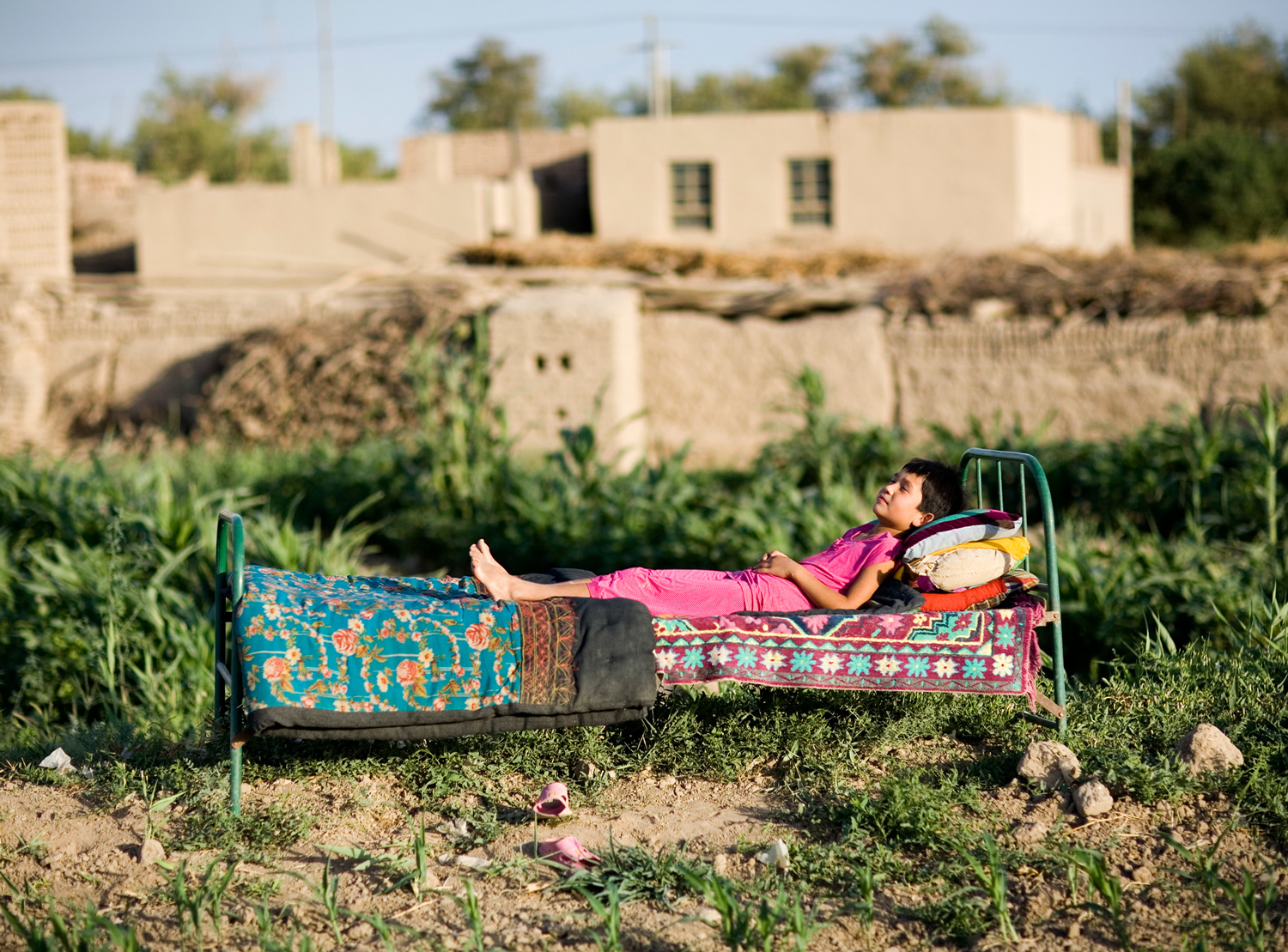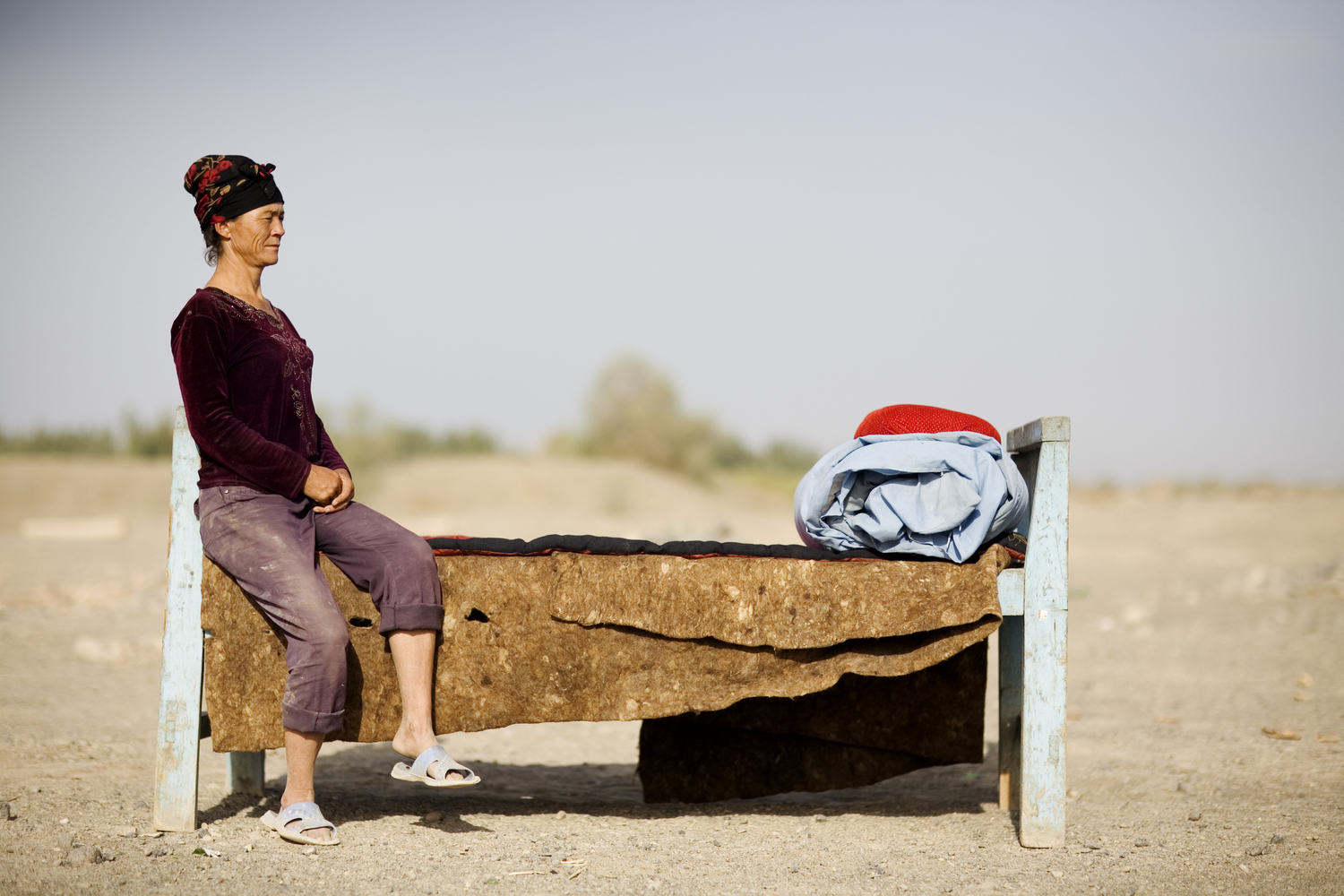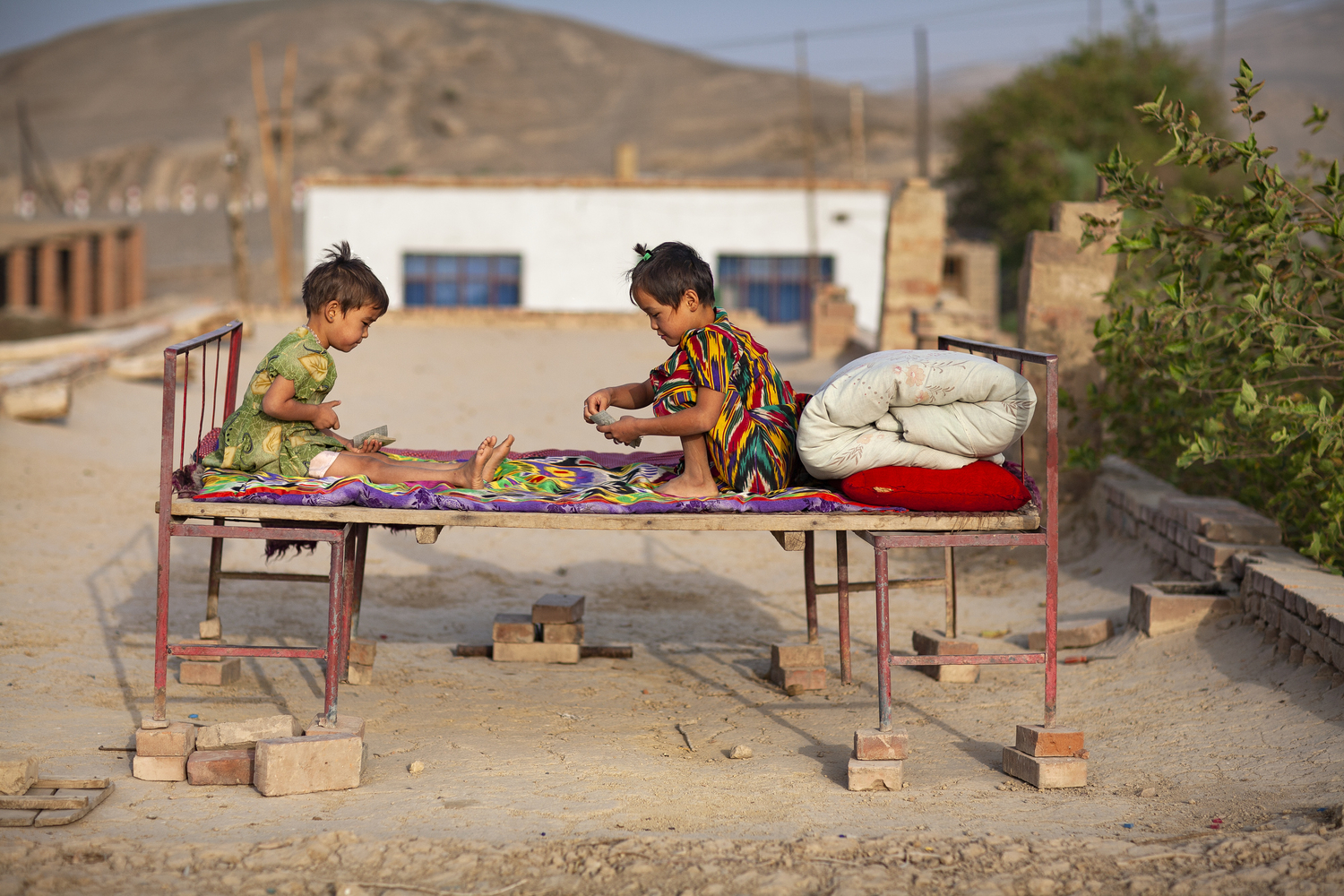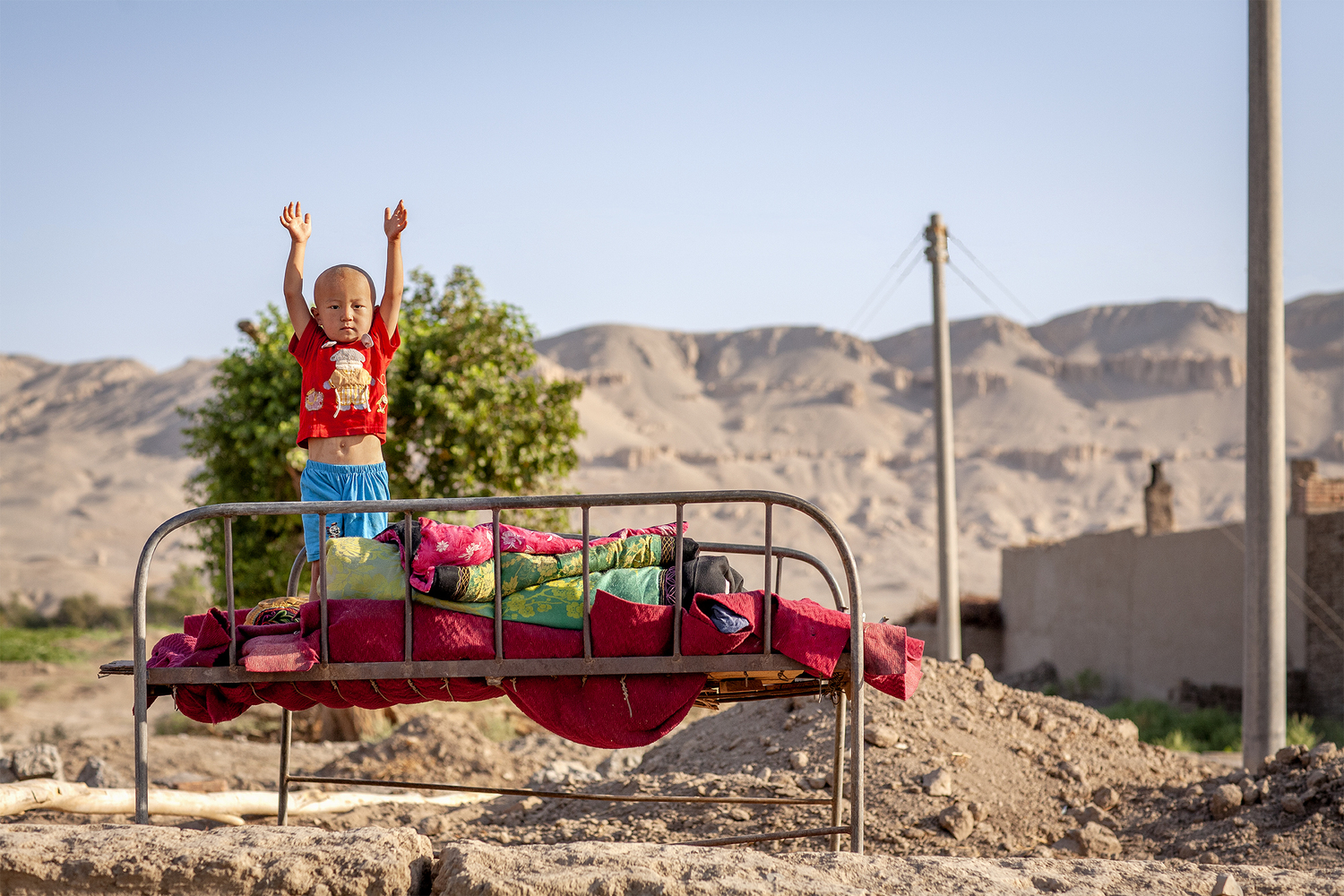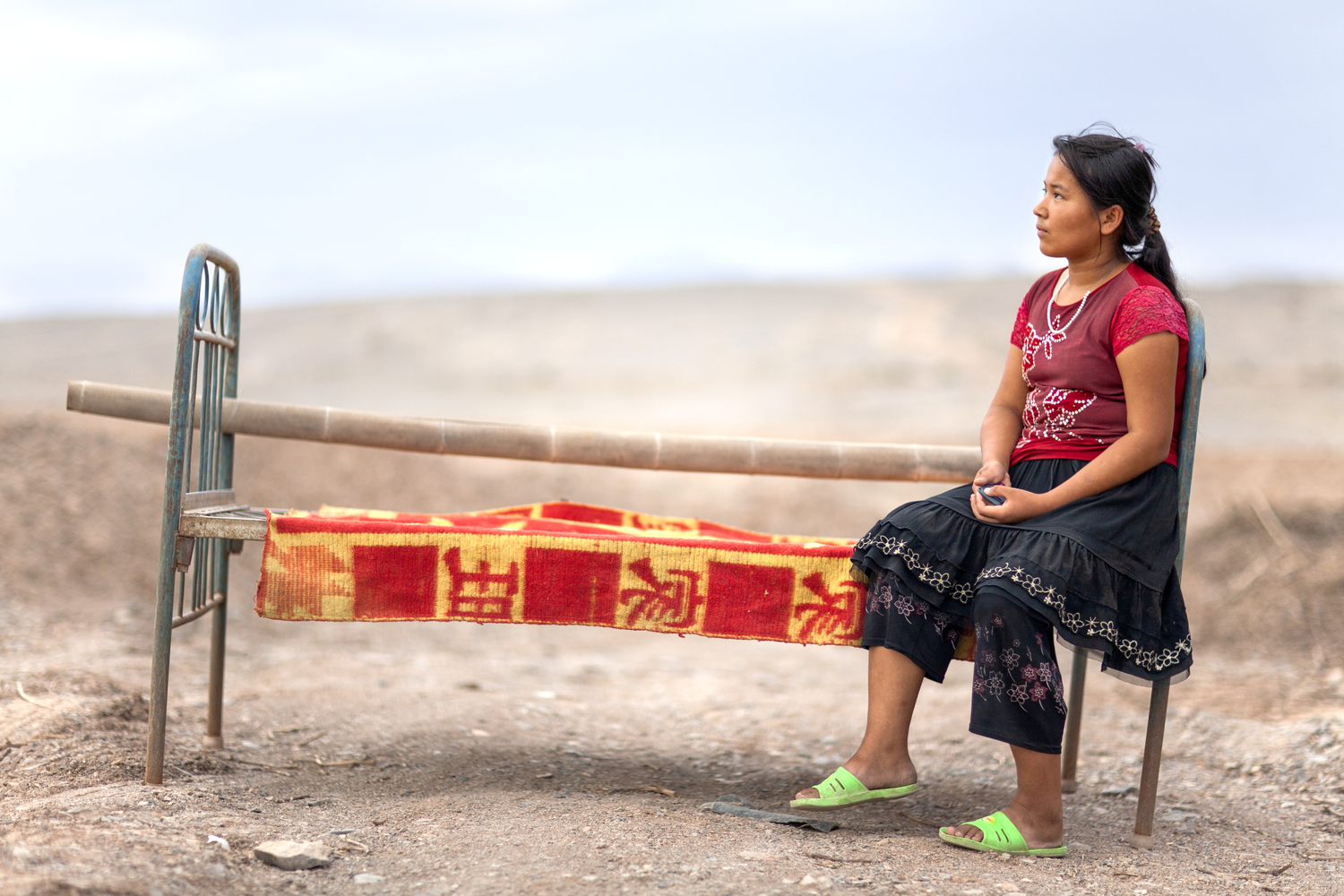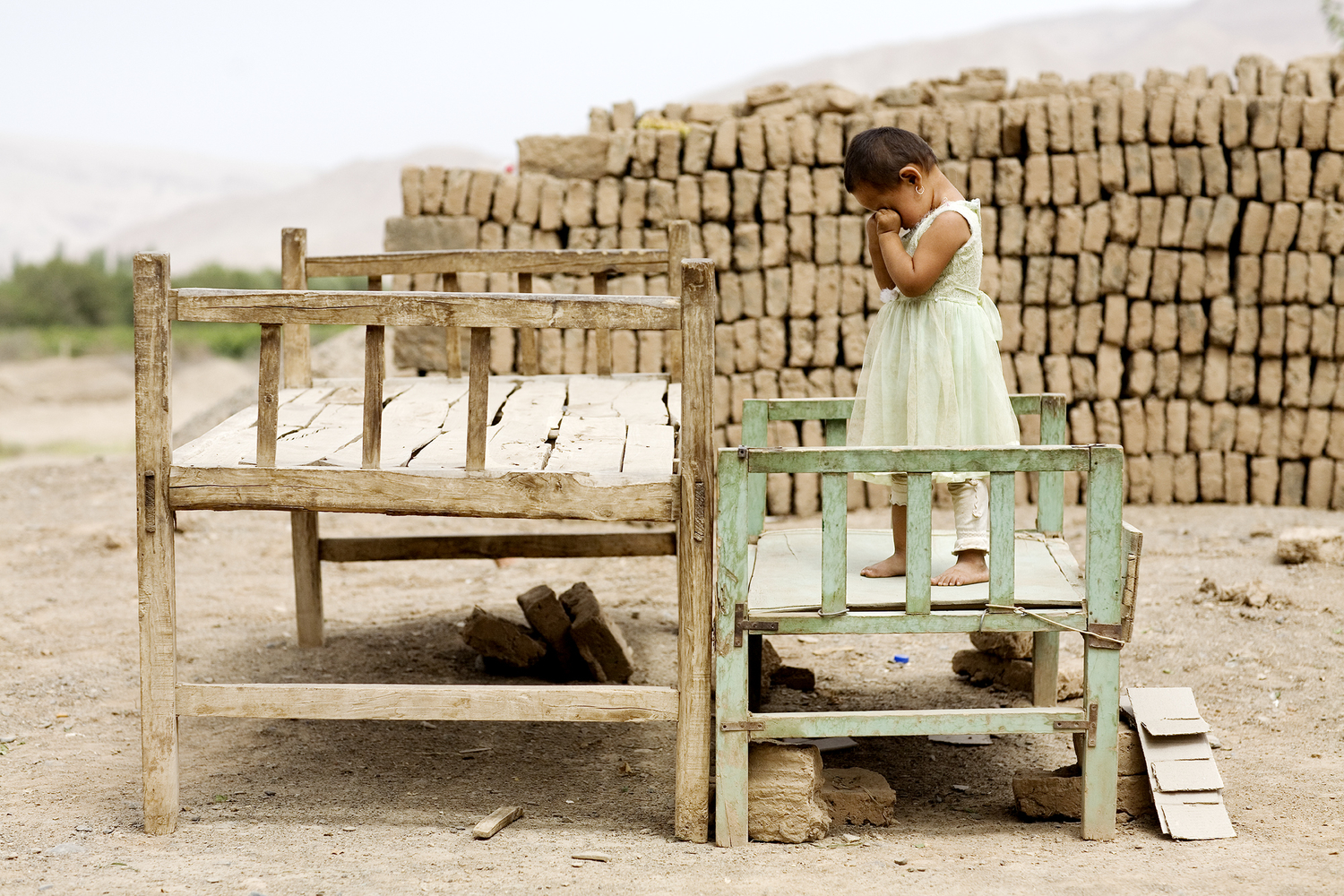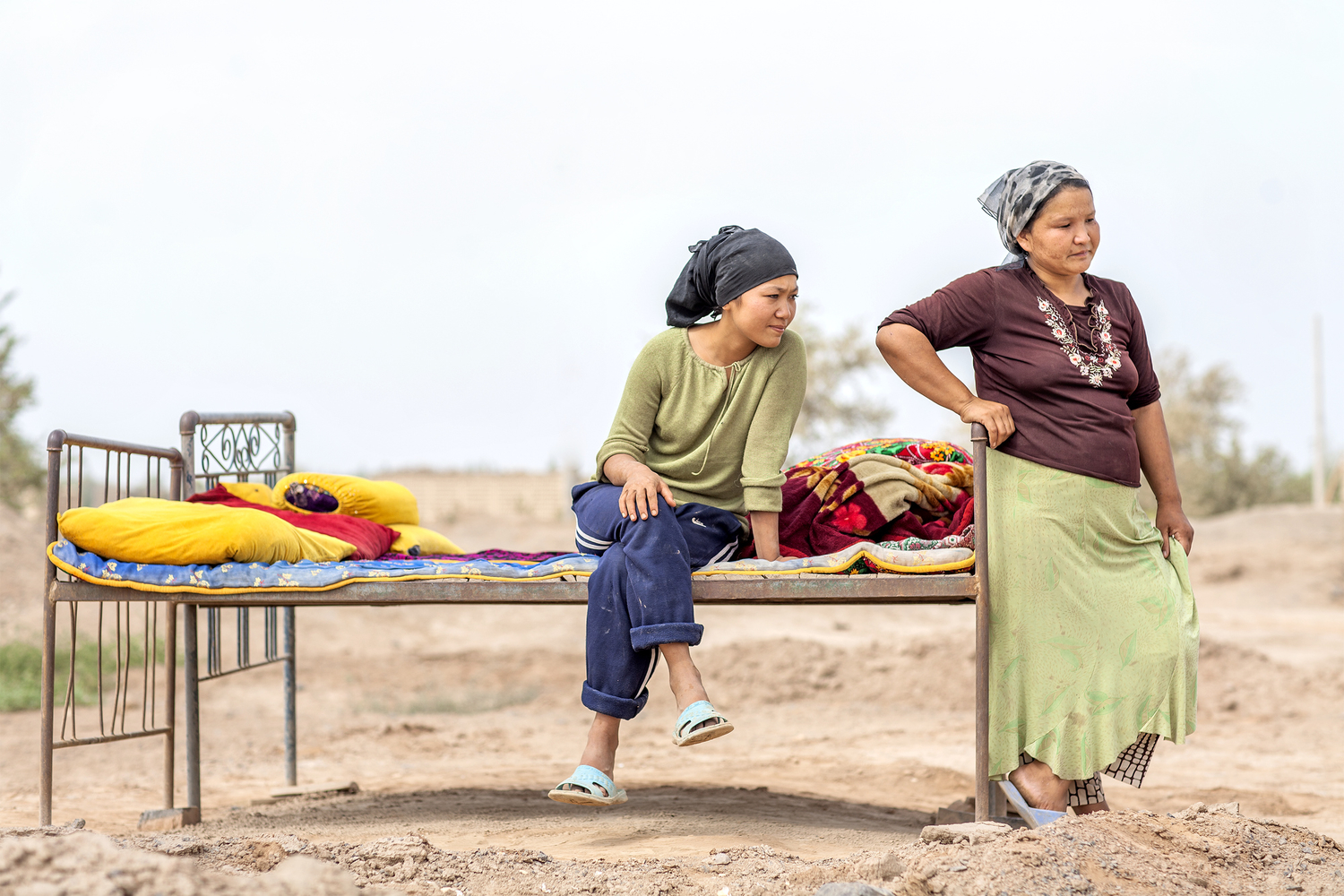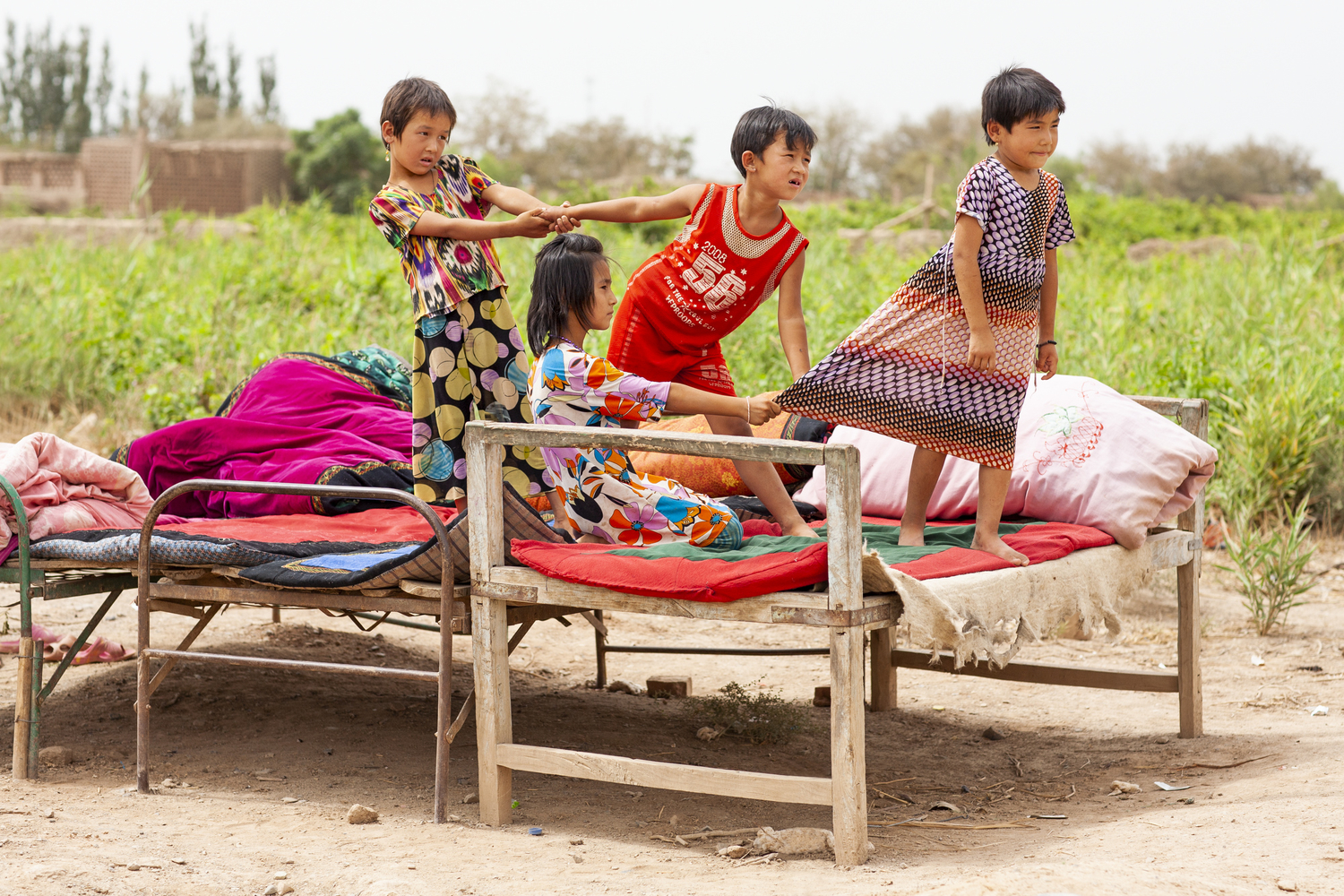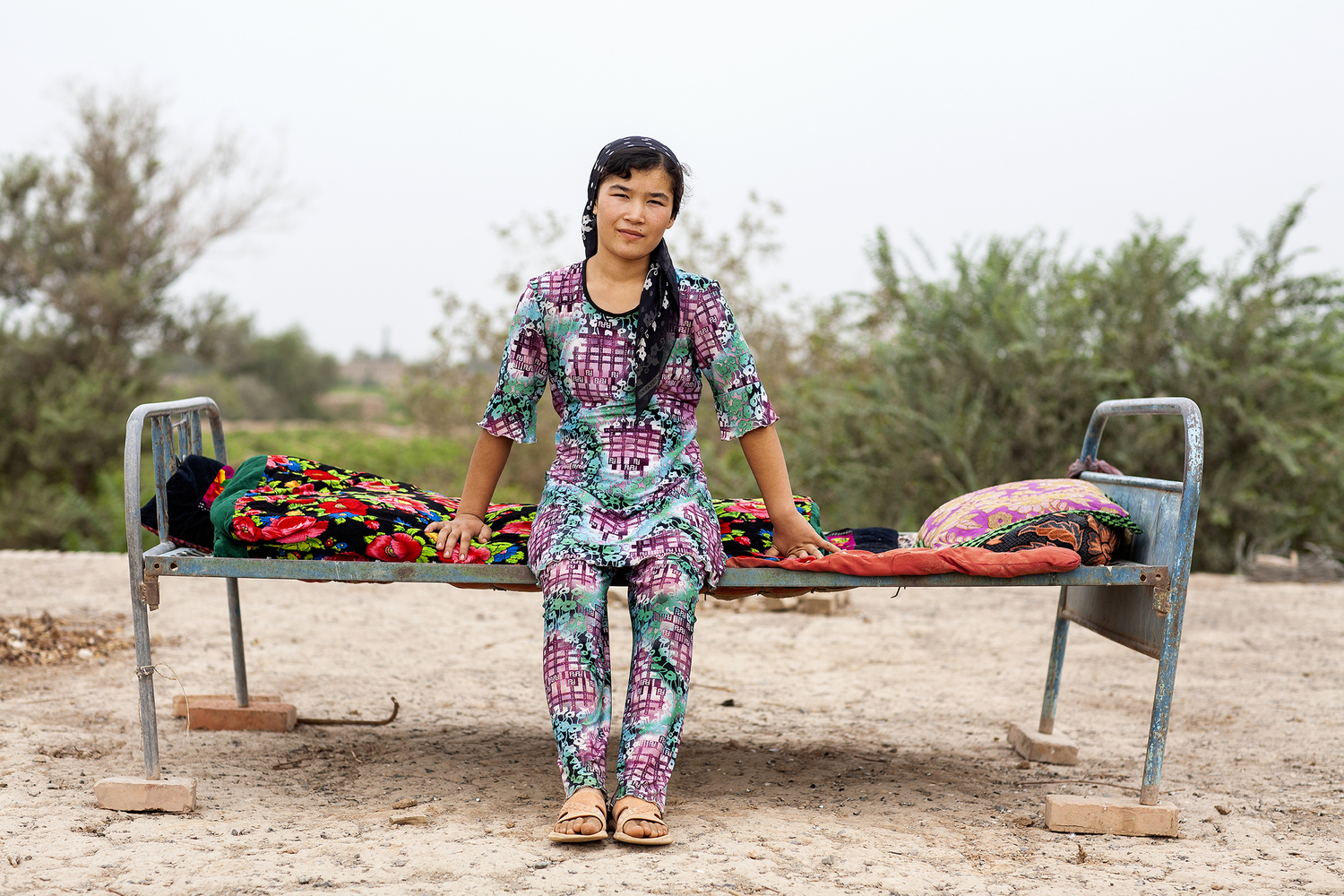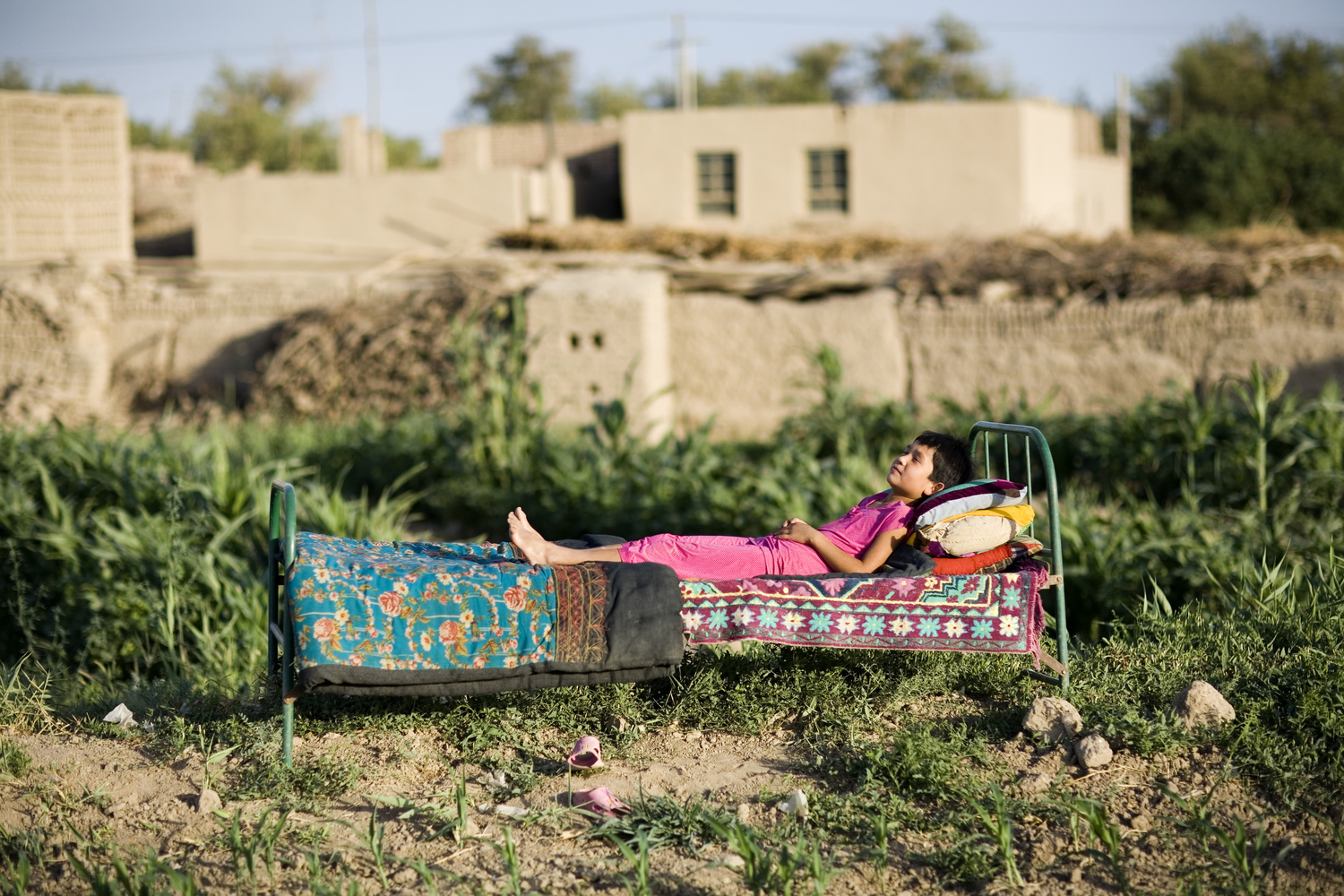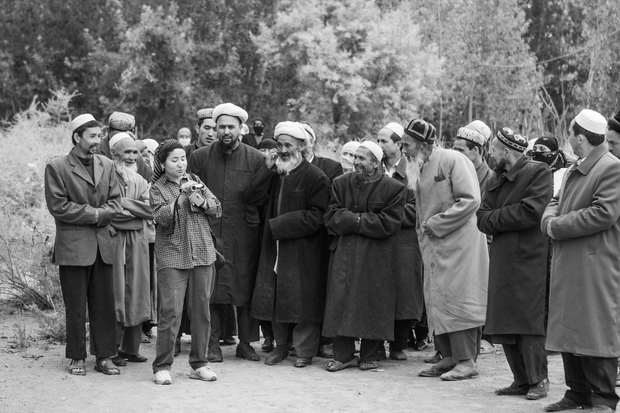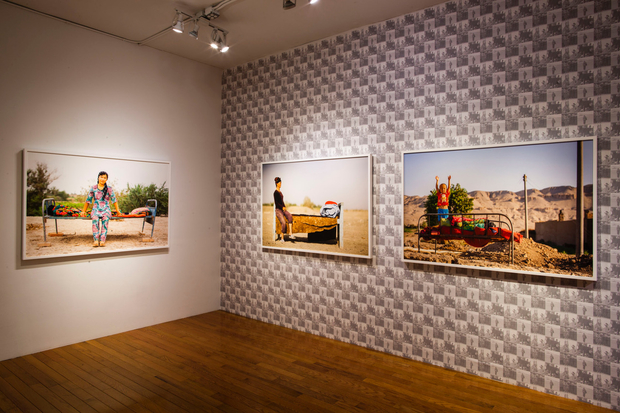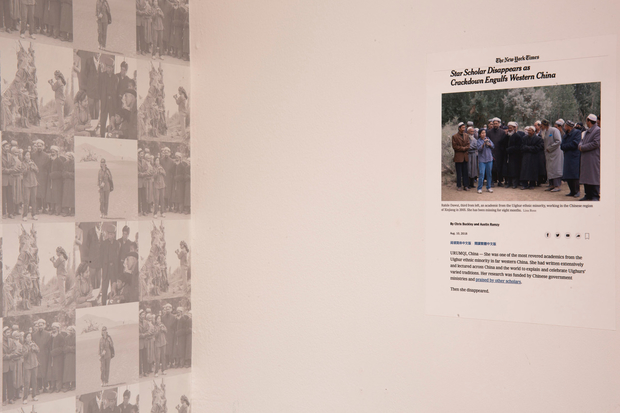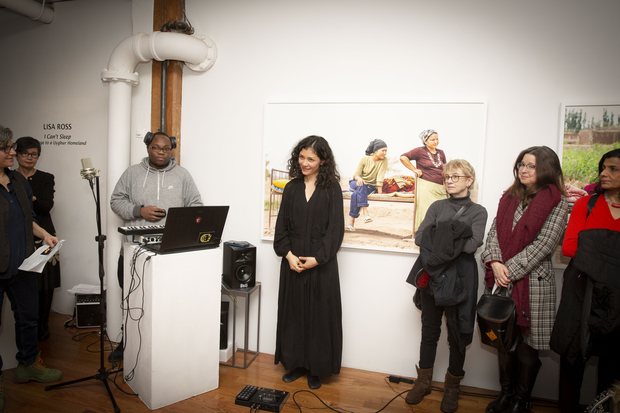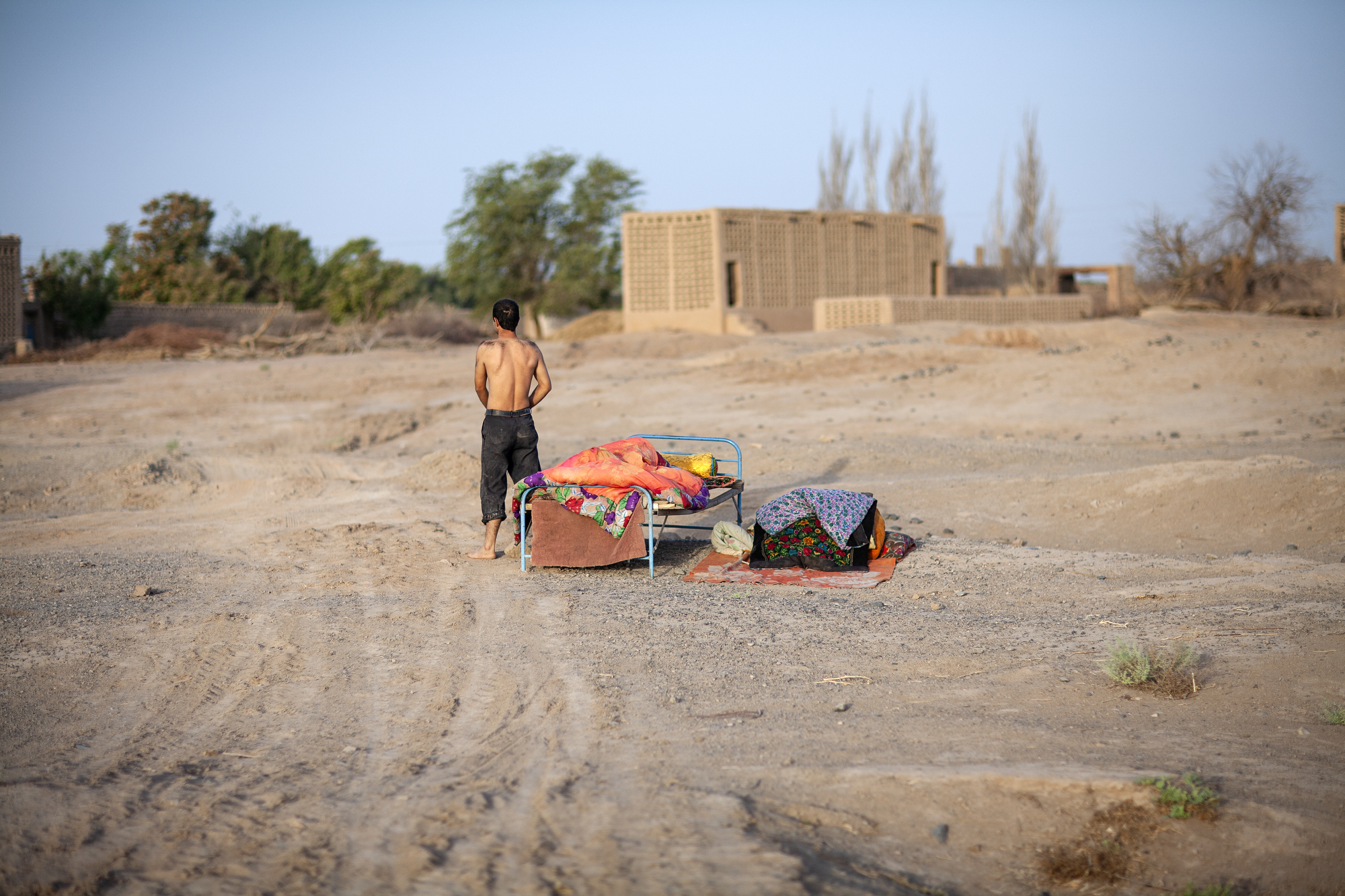In the 2000s, New York-based artist Lisa Ross traveled to the city of Turpan in China’s Xinjiang Uighur Autonomous Region and photographed local people on the beds that they keep in their fields. The portraits in that series are currently on exhibit at the Miyako Yoshinaga gallery in New York through March 16, 2019. ChinaFile’s Visuals Editor, Muyi Xiao, interviewed Ross about the work and its connection to the campaign of repression and incarceration of Uighurs taking place in Xinjiang today.
Muyi Xiao: Tell me about your project, “I Can’t Sleep: Homage to a Uyghur Homeland.” What is it about?
The primary focus of “I Can’t Sleep: Homage to a Uyghur Homeland” is a group of portraits of women and children on their beds, during the day, outdoors. The beds are in wide open, dry desert fields, on roof tops, or on the edge of oasis villages. The beds in the photographs are exactly where they are slept in by their owners. These photographs were made in Turpan, which is extremely hot and dry during the summer months, and it’s the tradition in Turpan for most people to sleep outdoors. Despite the extreme heat, Turpan has a unique and ancient irrigation system making the fertile land perfect for growing grapes, and the region is famous for raisins. Turpan raisins are known by many to be some of the best in the world. Farmers whose job it is to oversee the drying of raisins work on arid, barren hills and often sleep where they are working. This explains why the beds in these photographs often have an otherworldly and dreamlike feel to them and why I was initially attracted to them.
Whenever I traveled to the Uighur homeland [Xinjiang] for my work, I always put aside a few days to focus on beds in the landscape. The traditional Uighur bed is made of wood and uses only dovetailing, no screws or nails. In my mind, there was a strong relationship between the beds and holy sites/burial markers. Uighur Islam has historically been rooted in Sufism and the Muslim Saints are known to be in a state of eternal sleep. It is helpful to bury the dead close to the Saint as it’s believed that he or she will help with the transition into the afterlife.
In one way, there is a connection via sleep but there is also a physical relationship between the rectangle marker of the bed and burial and the landscapes they are seated in are similar. In addition, the material brought to the holy site to mark a prayer or a wish resonates with the bedding and clothing people wear.
What prompted you to make these images?
When I first saw a bed in the landscape, I felt I was looking at my dreams in a waking state.
They were so ethereal. I actually went straight into my imagination and stayed out of reality. I was at the time less interested in how the beds got there and why people slept in them than the visual experience and poetry of a bed in a barren landscape. The longer I photographed the beds, the more their owners began to enter the frame. The longer I spent in the Uighur homeland, the more I felt it was okay to include people in the photographs, to invite them in, to start a dialogue and have clear intention.
As I understand, these photos were taken more than a decade ago. Why did you decide to show these works now?
I had initially created a body of work of empty beds alone in the landscape and also on rooftops. This work was called “After Night.” I wasn’t comfortable showing portraits of Uighurs in my earlier work (including “Living Shrines in Uyghur China”) in part because I am not from there, in part because I wasn’t sure how safe it was for the subjects, and in part because I found a person could be “felt” even more strongly in their “absence.” The focus of my earlier work was on the experience of the objects people created, such as the markers at holy sites. I found the impact of the image to be stronger when the human figure was absent.
In this work there is a big shift as the human figure is prominent if not the central aspect of each one of these photographs. Who are the Uighur? What is Uighur culture? Right now there is an urgency to these questions.
This past summer, Miyako Yoshinaga came to my studio to choose a photograph of an empty bed in a landscape for an exhibition she was having called “How Many Miles to Babylon,” which was about healing from illness. She instead chose an image of two beds in a rural landscape with a child crying on her tiny bed of pale green. The child is wearing pale green and her dress echoes the bed as her feet are planted firmly on the wood.
As the summer group exhibition was coming to a close, The New York Times published an article about my good friend Rahile Dawut. Rahile is a folklorist/anthropologist; a cherished professor at Xinjiang University, located in the main city of Urumqi. Rahile had disappeared in December 2017. She was not only a great friend but was integral to the work I was able to make over the years. She disappeared along with 56 Uighur lecturers and researchers, some of whom are known to have been imprisoned, in certain cases, such as that of the President of Xinjiang University, a beloved father and husband and a geologist, with a death sentence. Often upon their sentencing, scholars are labeled two-faced and are punished for the very things they were honored for in the past.
In addition to Uighur academics, writers, musicians, actors, and other intellectuals have disappeared along with as many as two million Uighur citizens. The facts are dizzying. During my visit this past summer (2018), I felt a total shift and an overwhelming presence of police officers and convenience police stations, surveillance cameras, check points, body scanners, metal detectors, and enforced citizen peacekeeping groups required to carry wooden clubs.
When I returned to the U.S. in August 2018, many articles were being published and because of this, Miyako invited me to exhibit photographs of beds with their owners.
It was now time to show Uighurs in their everyday life as their existence and traditions are under great threat of disappearance.
What was the process like for making this body of work?
It was a very intense process because I wanted to find a way to address what is happening and the photos on which the exhibition is focused have a calm and quietness about them. They are strong images and speak to viewers, but they do not tackle the current situation. I know that a lot of Uighurs in the diaspora, including Rahile’s daughter, were terrified of speaking up for fear that their family members would be punished. There is a system of terror in place where Chinese police are getting contact information of Uighurs living abroad and giving people in the diaspora warnings for speaking up.
So with all of the trauma, I really felt the weight of making something that matters and resonates on many levels.
I decided to create a wall mural of Rahile, by repeating four photographs of her over and over. I chose photos of her working as an anthropologist in the field, photos I made of her back in 2005 when we traveled together for four weeks. I then changed them to black and white and into shades of gray. Each photograph is cropped to four inches square but the mural installed is 30 feet long and 11 feet high. One of the four photos is the same image used in the New York Times article, and the article is installed on the gallery wall when you first walk in. I hope that a relationship is drawn between the Times article on Rahile and the wall mural, which is a background difficult to ignore.
Do you have a story or detail from this process that still resonates with you? Do you know what has happened to any of the subjects of these photos? What is their life like now?
The “I” in “I Can’t Sleep” is ambiguous. It can be read as me the artist. It can be those in the Uighur diaspora, as each person fears for the safety of their family and friends. The “I” can be the subjects sitting or standing on their beds. We cannot know what has come to happen to them directly. We can assume they are affected by the current political situation in their towns and villages. Every Uyhgur I know knows someone who has been disappeared. There are between 11 and 15 million Uighurs. If up to two million are disappeared and the children of those people are in orphanages, we can guess that one tenth of the population is gone.
Personally, I was losing sleep as news spread. I was losing sleep as I stayed up thinking of ways to address what is happening. I wanted to make something meaningful.
The wall mural of Rahile permitted for a dialogue around the current situation. However, it was not quite a broad enough dialogue. I felt we needed one more element, which was the performative and the Uighur body—which is not mine. So Mukaddas Mijit, a Uighur dancer, musician, filmmaker, and ethnomusicologist, was integral to the success of this exhibition. Performative interventions are by definition frequently political in nature, and that was attractive. I wanted the performance to become an intervention within the space and the existing installation. As luck would have it, the Watermill Center in Long Island graciously offered us a one-week mini-residency a couple of weeks before the exhibition. Mukaddas had been in New York a few months prior and met my painter friend Anthony Varalli, with whom I share studio space. When we discussed the performative intervention across oceans on WhatsApp, Mukaddas wrote and said she had a dream that she collaborated with Anthony as a musician. I was hoping we’d look for a Uighur musician but Mukaddas wanted to work experimentally and intuitively felt Anthony had the chops. I told Anthony about her dream, and he told me that in fact he was a musician. I hadn’t known this and it was a great surprise.
During the one-week residency, we created four-five performative interventions for the exhibition space. Each intervention honored a disappeared musician, poet, novelist, and scholar. For each work, Mukaddas started with the words or music of the person we were honoring and then she and Anthony began to conceptualize the piece. In the gallery, they were supported by Fire, who is a sound engineer. The gallery is an intimate space, and at times it was filled to capacity with visitors. The ability for everyone to connect with Mukaddas and to look in her eyes and for her to look back and speak in this creative and direct way through language and body was more powerful than I had ever imagined. My complete and total belief in art was renewed. It was evidence that art can do what no other action can do, which is speak to the heart in a very direct way. When art speaks affectively, it goes right to our core.
I see almost no men in your photographs. Why is that?
Men are the first to disappear. (Women disappear too, and in Rahile’s case her husband is still living at home.) I’ve been told that entire villages are missing men between the ages of 20 and 45 and that they’ve all been disappeared. The gallery is a small room, and I was limited in what I could show. Not showing men raises the question, “where are the men?” That is a very important question, and timely in regards to what is happening.
What has the response been like from people who have come to see your show?
The response has been very positive. Visitors are saying they are moved by the work and spend a long time in front of each photograph, paying attention to details and asking questions. I’m in the gallery at least every Saturday to share the experience, answer questions, and take people through the work. We have a list of articles with QR codes if anyone want to read more. Uighurs from the diaspora are expressing a sense of hope looking at this work. During the performative interventions with Mukaddas and Anthony Varalli, the response was tremendous. Everyone in the room was completely engaged. Often, tears and hugs were shared during this time both by those who knew little and those that knew each person being honored. The night of the opening was unforgettable as so many flowed in an out of the room and the crowd appeared never-ending.




